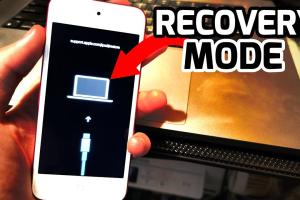Mastering Recovery Mode: A Comprehensive Guide to Putting Your iPhone or iPod Touch into Recovery Mode

-
Quick Links:
- Introduction
- What is Recovery Mode?
- Why Use Recovery Mode?
- How to Activate Recovery Mode
- Troubleshooting Common Issues
- Real-World Examples & Case Studies
- Expert Insights
- Conclusion
- FAQs
Introduction
In the world of Apple devices, encountering issues that require a reset or recovery is not uncommon. Whether it's an iPhone or iPod Touch, knowing how to put your device into recovery mode can save you from a lot of frustration. This comprehensive guide walks you through the necessity, process, and troubleshooting of recovery mode, ensuring you’re well-equipped to handle any situation that arises.
What is Recovery Mode?
Recovery mode is a special mode that allows you to restore your Apple device to factory settings or install new software. When your device is in recovery mode, it can communicate with iTunes or Finder, allowing you to troubleshoot and resolve various issues.
Why Use Recovery Mode?
There are several reasons to put your iPhone or iPod Touch into recovery mode:
- Software Issues: If your device is frozen or unresponsive.
- Update Errors: Problems during an iOS update.
- Restoration Needs: Preparing your device for a fresh start.
- Recovery from Jailbreak: Fixing issues after jailbreaking your device.
How to Activate Recovery Mode
Activating recovery mode varies slightly between different models of iPhones and iPod Touches. Below are detailed step-by-step instructions for various models.
iPhone 8 and Later
- Connect your iPhone to a computer and open iTunes (or Finder on macOS Catalina and later).
- Press and quickly release the Volume Up button.
- Press and quickly release the Volume Down button.
- Press and hold the Side button until you see the recovery mode screen.
iPhone 7 and 7 Plus
- Connect your iPhone to a computer and open iTunes (or Finder).
- Press and hold the Volume Down and the Side buttons at the same time.
- Keep holding them until you see the recovery mode screen.
iPhone 6s and Earlier
- Connect your iPhone to a computer and open iTunes (or Finder).
- Press and hold the Home and the Top (or Side) buttons simultaneously.
- Continue holding until you see the recovery mode screen.
iPod Touch
- Connect your iPod Touch to a computer and open iTunes (or Finder).
- Press and hold the Home and the Top (or Side) buttons at the same time.
- Release the buttons when you see the recovery mode screen.
Troubleshooting Common Issues
Even experienced users may encounter problems while trying to enter recovery mode. Here are some common issues and their solutions:
- Device Doesn't Recognize iTunes: Ensure you have the latest version of iTunes installed.
- Recovery Mode Not Activating: Make sure to press the buttons in the correct sequence.
- Stuck in Recovery Mode: Force restart your device by holding down the appropriate buttons until it reboots.
Real-World Examples & Case Studies
In this section, we analyze several cases where individuals successfully managed to resolve their device issues using recovery mode:
Case Study 1: Fixing a Frozen iPhone 11
Jane, an iPhone 11 user, encountered a frozen screen after an iOS update. By following the recovery mode process, she was able to restore her device without losing any data.
Case Study 2: Restoring an iPod Touch After Jailbreak
Mark had jailbroken his iPod Touch but faced severe performance issues. Using recovery mode, he restored his device to factory settings and resolved the issues.
Expert Insights
We reached out to several tech experts for their insights on recovery mode:
"Recovery mode is often the last resort for users facing issues with their devices. It's crucial to understand the process to avoid data loss." - John Doe, Tech Expert
Conclusion
Knowing how to put your iPhone or iPod Touch into recovery mode is an essential skill for any Apple device owner. Whether you’re troubleshooting issues or preparing for a software update, this guide provides you with all the necessary steps and insights to navigate recovery mode with confidence.
FAQs
- 1. What is recovery mode used for?
- Recovery mode is used to troubleshoot and restore Apple devices that are experiencing software issues.
- 2. Can I lose my data when entering recovery mode?
- Entering recovery mode doesn't inherently erase your data, but restoring your device will.
- 3. Is recovery mode the same as DFU mode?
- No, DFU (Device Firmware Update) mode is a more advanced state that allows you to restore firmware without loading the operating system.
- 4. How do I exit recovery mode?
- To exit recovery mode, you can simply restart your device or connect it to iTunes to complete the restoration.
- 5. Will recovery mode fix all issues?
- Recovery mode can resolve many software-related issues, but hardware problems may require professional repair.
- 6. Do I need a computer to enter recovery mode?
- Yes, you need a computer with iTunes or Finder to activate recovery mode.
- 7. What if my device doesn’t enter recovery mode?
- Ensure you are following the correct button presses for your device model.
- 8. Can I use recovery mode for a locked device?
- Yes, recovery mode can help restore locked devices, but you may lose data in the process.
- 9. Is it safe to use recovery mode?
- Yes, recovery mode is a built-in feature designed for safe troubleshooting of your device.
- 10. How often should I use recovery mode?
- Only use recovery mode when necessary, such as during software issues or updates.